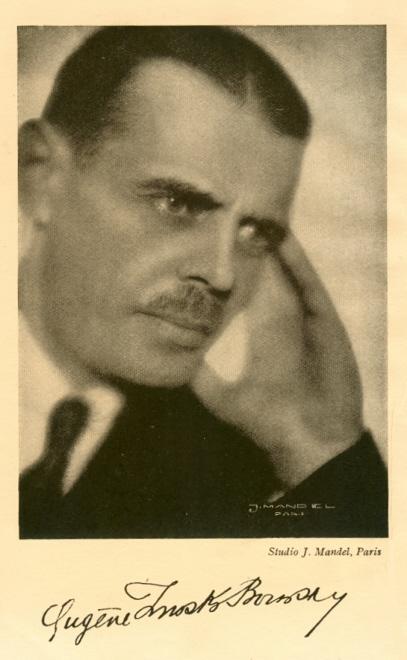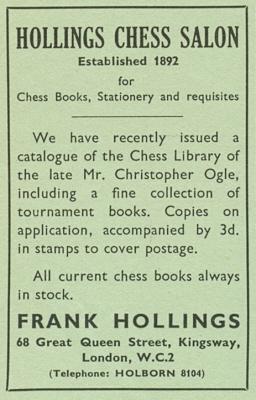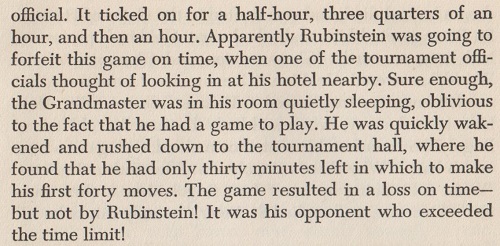
Edward Winter

See C.N. 6809.
Under the title ‘Or So They Say’ CHESS (14 April 1939, pages 276-277) stated:
‘E.A. Znosko-Borovsky published an article recently entitled “The bad moves of Dr Max Euwe”. Dr Euwe, always the gentleman, considered responding by means of a booklet entitled “The good moves of Znosko-Borovsky”, but couldn’t get hold of any material.’
From page 325 of The Golden Dozen by Irving Chernev:
‘Eugene Alexandrovich Znosko-Borovsky (a resonant name if ever there was one) once published a monograph called “Capablanca’s Mistakes”. Capablanca’s response to this was to tell the author that he had tried to write a work called “Znosko-Borovsky’s Good Moves”, but had to give it up as he could not find enough material.’
(1562)
Znosko-Borovsky wrote an article entitled ‘Capablanca’s Fehler’ in the January-March 1926 issue of Kagans Neueste Schachnachrichten (pages 150-154). Around the same time he published a critical article in L’Echiquier (February 1926, pages 26-27) called ‘Capablanca’s Fehler’.
We have found no trace of a reply by the Cuban.
(1618)
On page 20 of the April 1994 Chess Life, Andy Soltis rehashes a rickety anecdote:
‘Shortly after José Capablanca became world champion Znosko-Borovsky published a booklet of the Cuban’s losses called Capablanca’s Errors. Asked about it, Capa said he hoped to write a book called Znosko-Borovsky’s Good Moves but, he said, “Unfortunately, I didn’t succeed in finding material for it”.’
Mr Soltis provides no evidence regarding Znosko-Borovsky’s alleged booklet or Capablanca’s alleged dialogue. (We can add that Znosko-Borovsky did write an article called ‘Capablanca’s Fehler’ on pages 150-154 of the January-March 1926 Kagans Neueste Schachnachrichten; it discussed positions from seven games, four of which the Cuban won.)
A similar tale, with Euwe replacing Capablanca, appeared on pages 276-277 of the 14 April 1939 issue of CHESS.
(2032)
From page 54 of the February 1927 Wiener Schachzeitung:

That was in a spoof issue (4/1927), comprising jokes and parodies. See C.N. 6452 for another example, concerning Alekhine.
Some further citations:
Of Capablanca’s own games it has been written, with justice, that they breathe a serenity, a lucid crystal clarity, a type of model perfection. Indeed, that they are the product of supreme chessboard art.’
Raymond Keene, on page 40 of The Times (Review Section), 19 November 1988;
Of Capablanca’s own games it has been written, with justice, that they breathe a serenity, a lucid crystal clarity, a type of model perfection. Indeed, that they are the product of supreme chessboard art.’
Raymond Keene, on page 236 of Keene On Chess (New York, 1999);
Of Capablanca’s own games it has been written, with justice, that they breathe a serenity, a lucid crystal clarity, a type of model perfection. Indeed, that they are the product of supreme chessboard art.’
Raymond Keene, on page 237 of Complete Book of Beginning Chess (New York, 2003);
Of Capablanca’s own games it has been written, with justice, that they breathe a serenity, a lucid crystal clarity, a type of model perfection. Indeed, that they are the product of supreme chessboard art.’
Raymond Keene, on pages 40-41 of World Chess Championship Kramnik vs. Leko (Aylesbeare, 2004);
Of Capablanca’s own games it has been written, with justice, that they breathe a serenity, a lucid crystal clarity, a type of model perfection. Indeed, that they are the product of supreme chessboard art.’
Raymond Keene, on page 34 of Vishy’s Victory (2007);
Of Capablanca’s own games it has been written, with justice, that they breathe a serenity, a lucid crystal clarity, a type of model perfection. Indeed, that they are the product of supreme chessboard art.’
Raymond Keene, on page 21 of Battle of Bonn (2008);
Of Capablanca’s own games it has been written, with justice, that they breathe a serenity, a lucid crystal clarity, a type of model perfection. Indeed, that they are the product of supreme chessboard art.’
Raymond Keene, on page 58 of Carlsen-Anand Match for the World Chess Championship (Bronx, 2013).
As regards the second paragraph in each of those seven passages, the uncredited writer of the ‘lucid crystal clarity’ remark was Harry Golombek, on page ix of Capablanca’s Hundred Best Games of Chess.
(10316)
On page 84 of Chess An Illustrated History (Oxford, 1990) Raymond Keene gave another version of the quote about Capablanca:
‘Of his games, it has been declared that they breathe “a serenity, a crystal clarity, a perfection which is the result of the highest art”.’
If chess literature is to feature anecdotes, let them at least have a point. One story, set during the London, 1922 tournament, which has some purpose was related by David Hooper in the Capablanca entry of Anne Sunnucks’ Encyclopaedia of Chess:
‘These two rivals [Capablanca and Alekhine] were taken to a variety show by a patron, Mr Ogle, who recalled that Capablanca never took his eyes off the chorus, whilst Alekhine never looked up from his pocket chess set.’
In the first edition of The Oxford Companion to Chess (the Alekhine entry) the patron was named in full as Christopher Ogle, and in at least one other modern outlet he has been described as a ‘chess patron’. That remains to be demonstrated, but our particular interest is in knowing the source of the Ogle/ogling recollection and whether there are further reminiscences from London, 1922.
(3083)

This advertisement is on an inside cover page of the October 1956 BCM. Does any reader have a copy of the Hollings catalogue?
(6960)
From page 384 of the September 1922 Chess Amateur, concerning London, 1922:
‘The International Congress concluded with the prize-giving meeting on Saturday, 19 August, over which Canon Gordon Ross (President of the British Chess Federation) presided, supported by Major Barnett MP, Mr L.P. Rees, Mr R.H. Stevenson and Mr Christopher Ogle.’
The ‘Anecdotes’ chapter in Irving Chernev’s book The Bright Side of Chess provides an opportunity for assessing his factual dependability in this field, and we have selected four stories more or less randomly.
On pages 13-14 Chernev expended 16 lines on describing how Mieses, bitter over his 13th-round loss to Gunsberg in the Vienna, 1903 tournament, exclaimed, ‘It is bad enough to get run over, but to get run over by a corpse is horrible’. Apart from an error regarding Gunsberg’s score before that game (it was +0 –10 =2, not +0 –11 =1), the factual basis of Chernev’s story is correct, although it might have been mentioned that the episode had been recounted by Gunsberg against himself (Chess Pie, 1922, pages 76-77):
‘I ought to mention the Vienna Gambit Tournament even if it is only for a good epigram made by Mieses. He was one of the few against whom I scored. The poor man afterwards said: “It is bad enough to get run over, but to get run over by a corpse is horrible.” (This refers to my low score.)’
Gunsberg’s final tally at Vienna, 1903 was +1 –15 =2.
(3089)
The second anecdote for consideration was presented by Chernev on page 17 of The Bright Side of Chess:
‘At Margate, in 1935, the height of hero worship was reached when a little boy approached a spectator of the tournament and asked him for his autograph. The onlooker explained that he was not a great chessplayer, nor was he particularly gifted in any other field. In short, his autograph could not possibly have any value. “But please, sir”, said the boy, “I saw you talking to Capablanca!”’
We are unable to say what source for this was available to Chernev, who was writing in the late 1940s, but Heinrich Fraenkel’s Foreword to Capablanca’s Last Chess Lectures (London, 1967) has the following on page 9:
‘I well remember seeing a good deal of Capa at the Margate tournament of 1935, where I played in the “Premier Reserves”; on one occasion I had the somewhat embarrassing experience of more than a hundred people crowding round my board, all of them turning their backs to my game. And who could blame them since at the next board, some 15 or 20 feet away, Capa was playing Reshevsky. I too would have preferred watching their game rather than playing my own.
Capa’s popularity with the “fans” was as immense as it was genuine. At some tournament, I forget which, I was chatting to Sir George Thomas when a small boy handed up his autograph book, which Sir George promptly signed. Then the boy handed the book to me and when I told him that surely there could be no point in getting my autograph he disagreed. “Oh yes, sir”, he said, “I must have your autograph too.” “But why on earth? It’s no good in your collection.” – “Oh yes, sir”, said the boy, his face beaming, “I saw you talk to Capablanca!”’
To avoid any misunderstanding, we add that Fraenkel’s Foreword is absent from the US edition, Last Lectures (New York, 1966).
(3090)
In a 24-line anecdote on pages 18-19 of The Bright Side of Chess Chernev related that ‘it was early in that brief career that Breyer found himself a contestant in a Hungarian tournament’. In Breyer’s game against von Balla the latter announced mate in three moves, then reconsidered and corrected his announcement to mate in four. Confronted with Breyer’s silence, von Balla examined the position further and found that there was no mate in four. ‘The more he looked, the more desperate his game appeared. He looked, he thought, he analysed, and then without making a move – von Balla resigned!’
No game has been found which fits in with this account.
(3091)
We now note that the Breyer/von Balla anecdote was given by Al Horowitz on page 39 of the December 1946 Chess Review, the main difference being that von Balla’s mate announcements were in two moves and three, rather than three and four as in the Chernev version. Reinfeld quoted the Horowitz story on page 287 of The Joys of Chess (New York, 1961).(3094)
‘Rubinstein was scheduled to play Norman in one of the rounds of the Hastings tournament in 1926. Norman was ready, but there was no sign of the great Polish master.’ That is how an anecdote begins on pages 20-21 of The Bright Side of Chess. Chernev relates that after Rubinstein’s clock had been ticking away for an hour an official found the master asleep in his hotel room. Having rushed to the tournament hall, Rubinstein had only 30 minutes left to make his first 40 moves, yet he went on to win the game when the time-limit was exceeded by Norman.
A problem with this arises from the outset, since Rubinstein did not participate in the Hastings tournaments of 1925-26 or 1926-27. He did, however, play in, and win, the 1922-23 event, defeating G.M. Norman in their individual game (second round, 28 December 1922). The BCM (February 1923, page 34) reported, ‘Rubinstein, though arriving on the scene more than half an hour late (he was usually late!), rapidly polished off Norman’. A source for Chernev’s anecdote remains to be discovered.
The game-score of the Norman v Rubinstein game can be found on page 64 of Akiba Rubinstein: The Later Years by J. Donaldson and N. Minev (Seattle, 1995), although we note that the BCM (February 1923, page 63) gave a further pair of moves at the end (24 Rf1 Qxd3).
(3092)
Reinfeld’s The Joys of Chess (page 284) also had the Rubinstein-Norman story, quoted from a piece by M.E. Goldstein in Chess World, 1946, which began, ‘A memory of Hastings 20 years ago …’ It will be recalled that Chernev unmindfully put 1926 as the date of the alleged episode.(3095)
From pages 20-21 of The Bright Side of Chess by Irving Chernev (Philadelphia, 1948):


Gerard Killoran (Ilkley, England) draws attention to Norman’s own account, in a chess column by Frank Rhoden on page 10 of the Hastings & St Leonards Observer, 20 April 1957:

(10318)
Anyone wishing to make chess history ‘fun’ by spreading unsubstantiated anecdotes and tittle-tattle has only to eschew specifics like dates and places and rely on the shadowy word ‘once’. From 2010 Chess Oddities by A. Dunne (Davenport, 2003) we scoop up the following selection:
‘World Champion Emanuel Lasker was once offered an opium scented cigar …’
‘Aron Nimzovich once broke his leg ...’
‘Aron Nimzovich once stood on his head ...’
‘Pal Benko once thought Mikhail Tal was trying ...’
‘Max Euwe once requested a game for the World Championship be postponed ...’
‘Akiba Rubinstein once won four brilliancy prizes in one tournament.’
‘Anatoly Karpov once listed his hobbies as ...’
‘Mikhail Tal was once signed to play the Devil in a movie ...’
‘Tal was once asked what chess piece he would like to be ...’
(3112)
A further illustration of the ‘once’ school of narrative comes from page 24 of Curious Chess Facts by I. Chernev (New York, 1937):
‘Steinitz was once arrested as a spy. Police authorities assumed that the moves made by Steinitz in playing his correspondence games with Chigorin were part of a code by means of which important war secrets could be communicated.’
The identical paragraph appeared on page 31 of Chernev’s Wonders and Curiosities of Chess (New York, 1974), whereas on page 89 of The Fireside Book of Chess by I. Chernev and F. Reinfeld (New York, 1949) the wording was slightly different:
‘Steinitz was once misjudged to be a spy. Police authorities assumed that the moves made by him in playing his correspondence games with Chigorin were part of a code by means of which important war secrets could be transmitted.’
We have yet to find any such incident mentioned in contemporary reports on the two-game cable match in 1890-91 between Steinitz and Chigorin, about which, incidentally, the then world champion wrote on page 107 of the April 1891 International Chess Magazine:
‘Never before in the history of our pastime has a chess contest created such widespread and literally universal interest during its progress as the one just concluded between myself and Mr Chigorin.’
We would, though, draw attention to the following passage by Walter Penn Shipley in the Philadelphia Inquirer, as quoted on page 62 of the American Chess Bulletin, March 1918:
‘We note in the daily papers a curious break in the affairs of Lorenz Hansen, a Dane, but who has been in this country for many years and is a naturalized citizen. Lorenz Hansen has been for many years an enthusiastic chessplayer and an able problem composer. We have published many of his problems in this column, and some of exceptional merit. Lorenz Hansen was recently arrested on a technical charge, the Federal authorities believing that he had a secret code and was communicating with someone at Grand Rapids, Mich. On further examination the secret code appears merely to have been a harmless correspondence game of chess, the moves, as usual, being sent by postal card. It is unnecessary to state that when the true state of affairs became known Mr Hansen was promptly released.
This adventure recalls one of the late William Steinitz. When he played his second match with Lasker at St Petersburg, before leaving this country Steinitz arranged an elaborate code whereby at slight expense he could cable the moves in his match to a syndicate of New York newspapers. Steinitz received a liberal compensation for his work. The old man had spent a great deal of time on perfecting his code, but unfortunately on arriving in St Petersburg the authorities promptly confiscated the code, stating that it was impossible to believe that it was merely for the purpose of cabling chess moves and in reality was to give secret information to parties in America. Being thus deprived of his code, he was unable to cable the moves of his match, and thereby lost the fruit of many months’ hard labor. At the termination of the match the code was returned to Steinitz by the Russian authorities, stating they had found it to be as represented, but then, of course, it was too late to be of any use to the world’s master. Steinitz’ breakdown was unquestionably partially due to his great disappointment in this matter.’
What truth there is in any of the above we have no idea, and for now we merely point out that the second match between Steinitz and Lasker was held in Moscow, not St Petersburg.
(3345)
From page 149 of How to Play Chess Like a Champion by F. Reinfeld (New York, 1956):
‘Staunton was pompous and bombastic, a self-appointed dictator of the chess world. On one occasion a rival published a statement that he had won the majority of his games with Staunton. The next time they met Staunton thundered, “You can’t print that!” His rival stammered feebly that the statement was true. “What’s that got to do with it? Of course it’s true!”, Staunton raged. “But you still can’t print it!”’
In C.N. 1624 (see pages 132-134 of Chess Explorations) we quoted Chernev’s version of the anecdote in The Bright Side of Chess, as well as a (significantly different) account by G.A. MacDonnell in the Illustrated Sporting and Dramatic News. In both cases Staunton’s rival was named as Löwenthal. Do any other nineteenth-century sources discuss the alleged episode?
(4030)
See Falkbeer, Staunton and Löwenthal.
Latest update: 31 March 2025.
To the Chess Notes main page.
To the Archives for other feature articles.
Copyright: Edward Winter. All rights reserved.